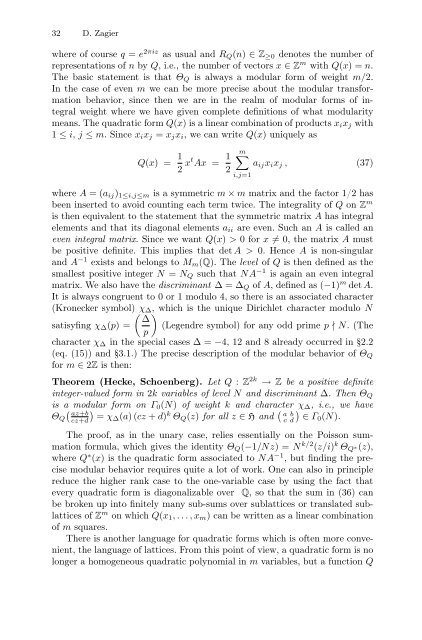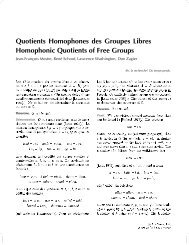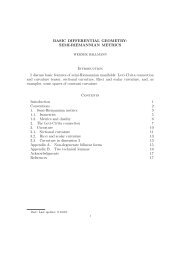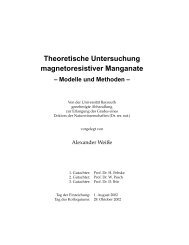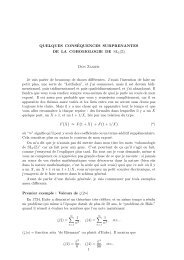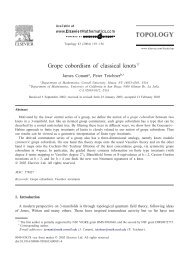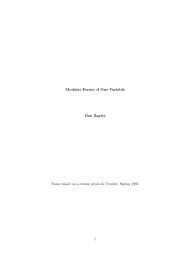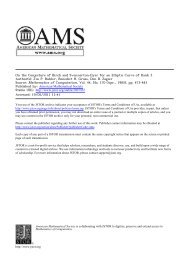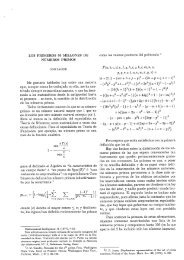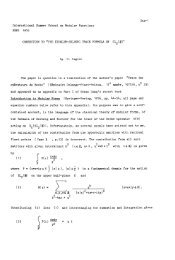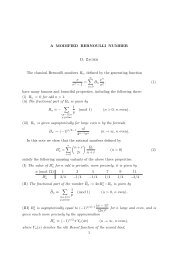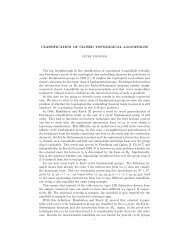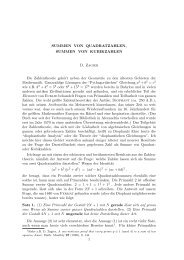Elliptic Modular Forms and Their Applications - Up To
Elliptic Modular Forms and Their Applications - Up To
Elliptic Modular Forms and Their Applications - Up To
You also want an ePaper? Increase the reach of your titles
YUMPU automatically turns print PDFs into web optimized ePapers that Google loves.
32 D. Zagierwhere of course q = e 2πiz as usual <strong>and</strong> R Q (n) ∈ Z ≥0 denotes the number ofrepresentations of n by Q, i.e., the number of vectors x ∈ Z m with Q(x) =n.The basic statement is that Θ Q is always a modular form of weight m/2.In the case of even m we can be more precise about the modular transformationbehavior, since then we are in the realm of modular forms of integralweight where we have given complete definitions of what modularitymeans. The quadratic form Q(x) is a linear combination of products x i x j with1 ≤ i, j ≤ m. Sincex i x j = x j x i ,wecanwriteQ(x) uniquely asQ(x) = 1 2 xt Ax = 1 2m∑a ij x i x j , (37)i,j=1where A =(a ij ) 1≤i,j≤m is a symmetric m × m matrix <strong>and</strong> the factor 1/2 hasbeen inserted to avoid counting each term twice. The integrality of Q on Z mis then equivalent to the statement that the symmetric matrix A has integralelements <strong>and</strong> that its diagonal elements a ii are even. Such an A is called aneven integral matrix. Since we want Q(x) > 0 for x ≠0,thematrixA mustbe positive definite. This implies that det A>0. Hence A is non-singular<strong>and</strong> A −1 exists <strong>and</strong> belongs to M m (Q). Thelevel of Q is then defined as thesmallest positive integer N = N Q such that NA −1 is again an even integralmatrix. We also have the discriminant Δ=Δ Q of A, defined as (−1) m det A.It is always congruent to 0 or 1 modulo 4, so there is an associated character(Kronecker symbol) ( χ Δ ), which is the unique Dirichlet character modulo NΔsatisyfing χ Δ (p) = (Legendre symbol) for any odd prime p ∤ N. (Thepcharacter χ Δ in the special cases Δ=−4, 12 <strong>and</strong> 8 already occurred in §2.2(eq. (15)) <strong>and</strong> §3.1.) The precise description of the modular behavior of Θ Qfor m ∈ 2Z is then:Theorem (Hecke, Schoenberg). Let Q : Z 2k → Z be a positive definiteinteger-valued form in 2k variables of level N <strong>and</strong> discriminant Δ. ThenΘ Qis a( modular form on Γ 0 (N) of weight k <strong>and</strong> character χ Δ , i.e., we haveΘ az+b)Q cz+d = χΔ (a)(cz + d) k Θ Q (z) for all z ∈ H <strong>and</strong> ( abcd)∈ Γ0 (N).The proof, as in the unary case, relies essentially on the Poisson summationformula, which gives the identity Θ Q (−1/N z) =N k/2 (z/i) k Θ Q ∗(z),where Q ∗ (x) is the quadratic form associated to NA −1 , but finding the precisemodular behavior requires quite a lot of work. One can also in principlereduce the higher rank case to the one-variable case by using the fact thatevery quadratic form is diagonalizable over Q, so that the sum in (36) canbe broken up into finitely many sub-sums over sublattices or translated sublatticesof Z m on which Q(x 1 ,...,x m ) can be written as a linear combinationof m squares.There is another language for quadratic forms which is often more convenient,the language of lattices. From this point of view, a quadratic form is nolonger a homogeneous quadratic polynomial in m variables, but a function Q


